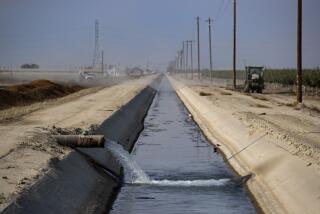Nitrates From Surface Pollution Found in 20% of Wells Tested
- Share via
WASHINGTON — Nearly 20% of sampled wells in the United States show evidence of nitrate compounds added to ground water by human activity, and more than 6% of the wells in the sample exceed a recommended maximum contaminant level for drinking water, the Interior Department said Wednesday.
It said that this may indicate pollution by other substances.
Nitrates, in high concentrations in food or drinking water, can cause the rare disease methemoglobinemia in babies and may react with other compounds in the digestive tract to form chemicals that can cause cancer in laboratory animals.
‘What Else Do You Have?’
“The significance is not so much the level of concentration found, but an indication of the probability that surface activity is affecting the (ground) water. The question is: If you have nitrates, what else do you have?” said David W. Moody of the U.S. Geological Survey in discussing the survey’s second annual national water summary at a news conference.
He was among officials who directed preparation of the summary.
Many environmental groups have called ground water pollution the “coming water crisis” because of pollution from dangerous chemicals in pesticides and fertilizer and from industrial activity, notably the leaching of chemicals from landfills.
The Geological Survey summary used nitrates as an indicator chemical because, Moody said, “we do not have nearly as much information as we would like” about other pollutants.
Robert Broadbent, assistant secretary of the Interior for water and science, said that he thought it would take two or three years to assemble data on pollution of ground water by toxic metals alone.
124,000 Wells Sampled
Data from the survey’s computerized files covering nearly 124,000 wells sampled over the last 25 years showed that nearly 24,000, more than 19%, carried nitrate compounds above three milligrams per liter.
The Environmental Protection Agency has established 10 milligrams per liter as the recommended maximum contaminant level in drinking water. More than 6% of the wells exceeded that. Not all wells are used for drinking water.
Nitrate compounds may occur naturally in ground water, and survey scientists arbitrarily chose three milligrams as the level indicating probable addition from fertilizers, livestock waste, human waste through septic tanks and other sources, including acid rain.
Many of the high-nitrate wells are in states that are heavy users of fertilizers.
The report said: “The major inputs of nitrate have occurred over the last 40 to 50 years. This is a short period of time in terms of ground water movement in some aquifers, and one must consider that the total effects of existing inputs may not yet have occurred in many areas.”
Provides Drinking Water
Ground water provides more than half of the nation’s drinking water--97% in rural areas--40% of irrigation water and 26% of water for industrial use.
Ground water use has increased greatly since 1950, with current withdrawals of about 88 billion gallons a year. In some areas, such as the Texas Panhandle, heavy withdrawals have reduced the water table so much that pumping costs are becoming prohibitive, and Broadbent said that farmers there “are going to go out of business or change to dry-land farming.”
“I don’t see a crisis for drinking water or industrial water,” he said.
More to Read
Sign up for Essential California
The most important California stories and recommendations in your inbox every morning.
You may occasionally receive promotional content from the Los Angeles Times.













